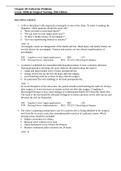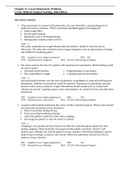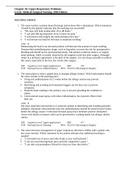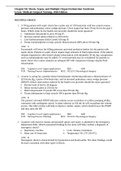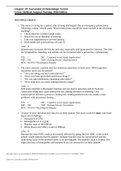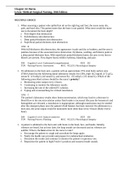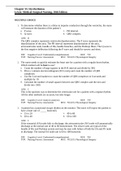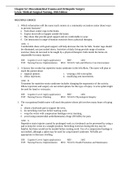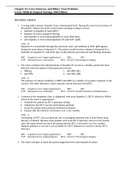Brightwood College
Latest uploads at Brightwood College. Looking for notes at Brightwood College? We have lots of notes, study guides and study notes available for your school.
-
268
- 0
-
13
All courses for Brightwood College
- MA R155-BL-MW MA R155-BL-MW 1
- MATERNITY HESI HESI Maternity 2
- Maternity HESI 1 Study Guide 1
- Maternity HESI 1 TESTBANK Maternity HESI 1 TESTBANK 1
- Maternity HESI 1,2 Test Bank |Questions, Answers & Rationale, A+ Guide. 1
- Maternity HESI 1,2 Test Bank Questions, Answers & Rationale, A+ Guide 1
- MCKINNEY: EVOLVE RESOURCES FOR MATERNAL-CHILD NURSING, 5TH EDITION NURSING220 1
Latest notes & summaries Brightwood College
1. A 40-yr-old patient with suspected acromegaly is seen at the clinic. To assist in making the diagnosis, which question should the nurse ask? a. “Have you had a recent head injury?” b. “Do you have to wear larger shoes now?” c. “Is there a family history of acromegaly?” d. “Are you experiencing tremors or anxiety?” ANS: B Acromegaly causes an enlargement of the hands and feet. Head injury and family history are not risk factors for acromegaly. Tremors and anxiety are no...
1. After assessment of a patient with pneumonia, the nurse identifies a nursing diagnosis of ineffective airway clearance. Which assessment data best supports this diagnosis? a. Weak cough effort b. Profuse green sputum c. Respiratory rate of 28 breaths/minute d. Resting pulse oximetry (SpO2) of 85% ANS: A The weak, nonproductive cough indicates that the patient is unable to clear the airway effectively. The other data would be used to support diagnoses such as impaired gas exchange and...
1. The nurse teaches a patient about discharge instructions after a rhinoplasty. Which statement, if made by the patient, indicates that the teaching was successful? a. “My nose will look normal after 24 to 48 hours.” b. “I can take 800 mg ibuprofen every 6 hours for pain.” c. “I will remove and reapply the nasal packing every day.” d. “I will elevate my head for 48 hours to minimize swelling.” ANS: D Maintaining the head in an elevated position will decrease the amount of...
1. The nurse teaches a patient with chronic bronchitis about a new prescription for Advair Diskus (combined fluticasone and salmeterol). Which action by the patient would indicate to the nurse that teaching about medication administration has been successful? a. The patient shakes the device before use. b. The patient rapidly inhales the medication. c. The patient attaches a spacer to the Diskus. d. The patient performs huff coughing after inhalation. ANS: B The patient should inhale the...
1. A 78-kg patient with septic shock has a pulse rate of 120 beats/min with low central venous pressure and pulmonary artery wedge pressure. Urine output has been 30 mL/hr for the past 3 hours. Which order by the health care provider should the nurse question? a. Administer furosemide (Lasix) 40 mg IV. b. Increase normal saline infusion to 250 mL/hr. c. Give hydrocortisone (Solu-Cortef) 100 mg IV. d. Titrate norepinephrine to keep systolic blood pressure (BP) above 90 mm Hg. ANS: A Furos...
1. The nurse is caring for a patient who is being discharged after an emergency splenectomy following a motor vehicle crash. Which instructions should the nurse include in the discharge teaching? a. Check often for swollen lymph nodes. b. Watch for excess bleeding or bruising. c. Take iron supplements to prevent anemia. d. Wash hands and avoid persons who are ill. ANS: D Splenectomy increases the risk for infection, especially with gram-positive bacteria. The risks for lymphedema, bleed...
1. When assessing a patient who spilled hot oil on the right leg and foot, the nurse notes dry, pale, and hard skin. The patient states that the burn is not painful. What term would the nurse use to document the burn depth? a. First-degree skin destruction b. Full-thickness skin destruction c. Deep partial-thickness skin destruction d. Superficial partial-thickness skin destruction ANS: B With full-thickness skin destruction, the appearance is pale and dry or leathery, and the area is p...
1. To determine whether there is a delay in impulse conduction through the ventricles, the nurse will measure the duration of the patient’s a. P wave. c. PR interval. b. Q wave. d. QRS complex. ANS: D The QRS complex represents ventricular depolarization. The P wave represents the depolarization of the atria. The PR interval represents depolarization of the atria, atrioventricular node, bundle of His, bundle branches, and the Purkinje fibers. The Q wave is the first negative deflection...
1. Which information will the nurse teach seniors at a community recreation center about ways to prevent fractures? a. Tack down scatter rugs in the home. b. Expect most falls to happen outside the home. c. Buy shoes that provide good support and are comfortable to wear. d. Get instruction in range-of-motion exercises from a physical therapist. ANS: C Comfortable shoes with good support will help decrease the risk for falls. Scatter rugs should be eliminated, not just tacked down. Activi...
1. A young adult contracts hepatitis from contaminated food. During the acute (icteric) phase of the patient’s illness, the nurse would expect serologic testing to reveal a. antibody to hepatitis D (anti-HDV). b. hepatitis B surface antigen (HBsAg). c. anti-hepatitis A virus immunoglobulin G (anti-HAV IgG). d. anti-hepatitis A virus immunoglobulin M (anti-HAV IgM). ANS: D Hepatitis A is transmitted through the oral-fecal route, and antibody to HAV IgM appears during the acute phase of ...

